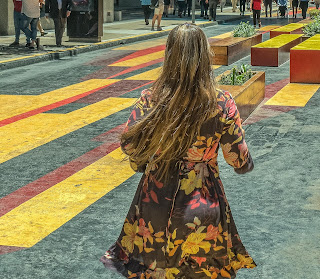Santiago
The voyage from Brazil with stops in the large and small ports of Uruguay, Argentina and Chile gave us a bucketful of rewarding experiences. We saw a lot and learned much about new places and the people who live there, their food and wine, and how they feel about their home countries, as well as their views of some of the larger world.
While we only scratched the surface of parts of South America, we now have more than a rudimentary knowledge of the geography of that fascinating continent, and we are also now more aware of the differences and the similarities between the people of the countries we visited and the people in our part of the world. We all share similar day-to-day pressures and concerns, political, environmental, economic, or family life. At the end of the day what was most gratifying for us was the friendliness of all the strangers we interacted with.
 |
| one small section of high-density Santiago, 5.6 million people |
The peoples of the South American continent are as much a mix of indigenous and varied ethnic origins as those who call North America home. Inequalities and tensions prevail above and below the equator, yet while we travel as tourists—privileged and casual observers—the conditions of the haves and have-nots have not gone unseen and unfelt, but alas, further commentary on the human condition is beyond the scope of this simple travel blog.
 |
| This shot is a closeup of a section in the photo, above. The window washer is hanging 100+ feet above the street, so I called this shot easy-peasy because he made it look that way. |
Santiago, this great big land-locked city, is our last stop before flying home, and we are ready to do just that—get back to family, friends and our own bed. Oh yes, and to work. One of is is only partially retired.
 |
| the audio was in English |
NOTE: This final posting is just a mix of images that caught my eye in this rather complex city. Admittedly, we were a little tired, and a little done, and I think Santiago did not capture a lot of our interest. Maybe also, we were kind of pampered on the ship, and now we were cut loose and cast adrift, as it were, fending more for ourselves, perhaps also biding our time until it was time to catch our plane.
 |
| any street in any city? |
The photo above reminds me of online logins where, in order to pass go, you have the click the I AM NOT A ROBOT box. If my picture is divided into squares you have to click each square that has a cell phone. If I had taken the photo a few seconds later maybe there would have been more squares to prove you're not a robot: the guy on the scooter reaching for his device? The woman reaching into her bag for her smartphone? What about the guy leaning against the tree talking on his phone?
These eScooters are everywhere.
 |
| Hotel Continental in the upscale Nueva Las Condes part of Santiago |
=====================================================================
LOST IN TRANSLATION
 |
| NOT SUPPORTING THE DOORS? what glasses? |
The tramway—teleférico—took us above the city for some terrific aerial views, and then we rode the funicular down to the other end of town.
 |
| THIS COULD BE TRICKY?? |
 |
| I THINK I GET IT |
Am I being unfair, poking fun? After all, at least it was English.
 |
| foaming-by-the-glass wine |
 |
| hamburger—reminds me of Steve Martin doing Inspector Clouseau And, wow! That looks like $6,500! |
=====================================================================
 |
| from atop Santa Lucia |
 |
| Sky Costanara |
OLD CITY NEW CITY
SANTIAGO HAS IT ALL
 |
| skywalk |


Descending back down to the city on the funicular, one arrives at the old Bellavista neighbourhood. Why is there always so much more colour in the older, poor areas of the cities? Remember Buenos Aires, posting #3?
 |
| Pantaleón Restaurant |
 |
| we did not chow down at Pedro, Juan & Diego but love the name |
 |
| empanada man |
 |
| facing you |
 |
| melding of the minds |
It was so wonderful making new friends
on the ship. Alastair and Helen from
New Zealand, we have been missing our fun times together.
In closing, for readers who were looking for information about going on a cruise, who were doing some online research about the pros and cons of cruising, or who wanted to find out whether they should spend the big bucks and buy tickets for an Oceania cruise, oops, that's not what this blog was about. My blog was not a sales pitch for cruising or for a cruise line. Aah, if only you'd known about that before you got you this far. If you are reading this line, then I must have had you hooked. Thanks for hanging in there.





































